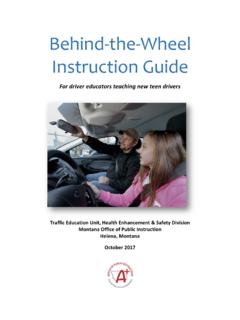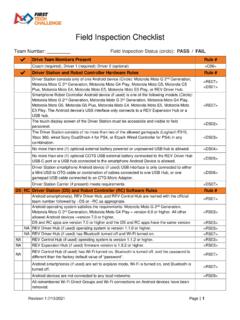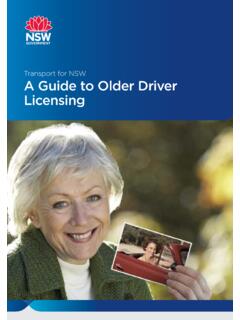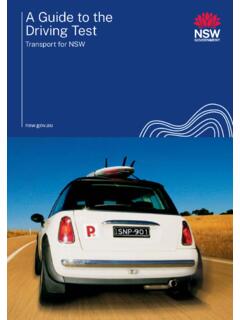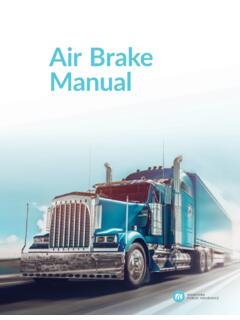Transcription of Behind-the-Wheel Instruction Guide - Montana Office of ...
1 Behind-the-Wheel Instruction Guide For driver educators teaching new teen drivers Traffic Education Unit, Health Enhancement & Safety Division Montana Office of Public Instruction Helena, Montana October 2017. The uniqueness of the in-car setting demands special consideration. Teaching someone to drive in a vehicle that moves at relatively high speeds through a dangerous and sometimes unpredictable environment is unlike any other educational setting. A distinct approach to teaching is required. Many teaching methods appropriate for use in the ordinary classroom are not suitable for a classroom on wheels.. In-Car Instruction : Methods and Content - A Manual for Teachers of Driver and Traffic Safety Education by William G. Anderson, Teachers College, Columbia University, 1968. Contents Introduction .. 1. Section 1 - Planning for In-vehicle Instruction .. 3. Teaching 3. Building on Past Experiences .. 3. Effective Directions .. 5. Section 2 Managing Students in the Mobile 10. Constructive Criticism.
2 10. Positive Reinforcement .. 11. Raising Awareness through Senses and Emotions .. 11. Addressing Internal Obstacles .. 11. Active Questioning and Listening .. 12. Recognizing and Taking Appropriate Actions when drivers Cannot Perform .. 13. Section 3 In-Vehicle Teaching Techniques .. 16. Common Errors .. 17. Teacher Commentary .. 17. Student Driver Commentary .. 18. Engaging the Observers in the Back Seat (Non-Driving Students) .. 18. Using the Instructor Mirror .. 19. Situational 19. Summarizing and Evaluating Each 20. Section 4 - Managing and Taking Control of the Vehicle (or when to use the instructor brake).. 21. Section 5 - Driver Appendix 1 - Professional Educators of Montana Code of Ethics .. 31. Appendix 2 - Skills Evaluation Appendix 3 - Pre-Drive checklist .. 33. Introduction This guidebook was developed as a resource for Behind-the-Wheel Instruction and evaluation of beginning drivers . Driver education can significantly improve and develop skills and safe driving habits to reduce crash risk for young drivers .
3 In-car lessons with structured learning and guided practice help students acquire and demonstrate legal, safe, responsible driving competence and habits. The Traffic Education Unit in the Health Enhancement and Safety Division of the Montana Office of Public Instruction excerpted and adapted this Guide from the Instructor's Guide of the 2017 Model Training Curriculum for the Teaching Task Instructor Preparation Program with permission from the Association of National Stakeholders in Traffic Safety Education (ANSTSE). It was developed by the Highway Safety Services, LLC and Teacher Training Working Group at ANSTSE in cooperation with the National Highway Traffic Safety Administration. The 1,237-page curriculum is available at Preparing for In-Car Instruction In-car lessons should reflect local driving environments and the rules of the road. The success of Behind-the-Wheel Instruction will depend on the completeness and accuracy of the route plans and lesson objectives. A concurrent, integrated plan of Instruction and in-car lessons gives students practice with lessons recently taught in the classroom.
4 Long delays between classroom Instruction and Behind-the-Wheel Instruction will require additional time in the car to review classroom Instruction . It is also important to have procedures, techniques, and route selections clearly written to avoid potential legal issues. Program administrators should have copies of the routes and lesson plans on file. Tips for Successful In-Car Instruction Select a drive route appropriate to the individual lesson objectives and student-driver's ability. Be prepared with an alternate route in case of detours or other traffic problems. At the beginning of each drive, make sure the student driver and back-seat observer(s). understand the lesson objectives; do a quick review of the preceding session. Check to make sure each student is issued a traffic education permit (TEP) that stays in the vehicle during drives. Be calm and patient, but be alert at all times. Do not become distracted from the instructional task. The teacher must maintain the highest level of care at all times to ensure the safe operation of the vehicle.
5 Headlights must be on at all times. Mirrors should be adjusted for each driver's use. Sit so the instructor's left hand can be quickly placed on the steering wheel, if necessary. Never leave students unsupervised in a vehicle with the motor running. 1. As with any instructional setting, food and beverages should not be consumed in the vehicle. Some instructors put all student cell phones and hand-held devices in the trunk during the BTW Instruction . Read the traffic environment ahead, to the sides and behind while observing the student driver's behavior and ask the student to verbalize the need to change direction or speed. When giving directions, first provide students with the path of travel and then state the action to take. For instance: At the second intersection, prepare to turn left.. Give directions four to six seconds before the maneuver and always check mirrors before giving directions. The novice driver will take more time to process information than an experienced driver. Avoid the use of terms with possible double meanings.
6 Instead of saying right to indicate a correct response to a question, say that's correct. It may be helpful to point in the direction you want the student to go. Demonstrate what and how to do something to save time. Demonstrations may be as simple as assisting with steering, using the instructor brake, using a drawing or magnetic board, or as elaborate as changing seat positions and actually demonstrating the appropriate actions. For each new maneuver, coach the novice driver through two or three practice trials, then allow practice without specific assistance or direction. If a mistake is made, have the student repeat the maneuver and verbally coach him/her, step by step, through the process. If a lengthy discussion or explanation is needed, move to a safe place to stop and park the vehicle. Use a legal parking area or parking lot. Do not park or stand on the roadway shoulder or impede traffic flow. Never allow a novice driver to drive blindly into a dangerous situation. Take control or give specific directions prior to entering the high risk driving area.
7 Ensuring student safety is the teacher's foremost concern. Involve the student driver in the evaluation of his/her performance. Complete the Student Driving Log on the back of the TEP immediately after each drive. It is very important to maintain accurate records for each student. Driver education programs offering the required six hours of in-car Instruction will need to schedule 12 half-hour lessons. Adapt and adjust the in-car lessons to accommodate longer drives, additional time, and to involve student observers in the lesson. 2. Section 1 - Planning for In-vehicle Instruction Each Behind-the-Wheel (BTW) lesson plan shall include content for the instructional objective, learning activities, anticipated problems, goal setting, and method of evaluation. After the instructional objectives, attach a copy of the route to the lesson plan. Identifying, Setting and Meeting Goals 1. Goals must fit the needs of traffic safety. 2. Goals could be the overall goal: What do I hope to achieve as a result of the training?
8 Or specific goals within each lesson. 3. The student should fully accept the goals and ensure the student subscribes to the basic goals of training (safe, social and environmentally conscious driving). 4. It is important that the goals meet the needs of the student and addresses concerns from previous lessons before moving onto the next step in the training process. 5. The instructor should encourage the student to identify their own goals, within the limits laid down by the training program and the law. T EACHING R ESPONSIBILITY. 1. Safe drivers are responsible drivers . This sense of responsibility can be developed in the driver training process if the student is empowered to make decisions, choices, identify their own goals, etc. 2. The student should not immediately make decisions, which could have serious highway safety implications, but the student should feel responsible for their own learning. 3. Students should be given responsibility right from the beginning of the training to get them accustomed to making decisions and choices on their own.
9 B UILDING ON P AST E XPERIENCES. Building on prior experience is another important principle to incorporate into driver training and to help set goals. 1. Learning is about connecting new elements with old elements and prior experience or building blocks on existing blocks. 2. Students bring to driver training a wealth of experience from life and often from driving itself. Many will have driven before and all will have had the opportunity since childhood to observe their parents and others drive. Most students have ridden a bicycle and all have been, and still are, pedestrians. 3. The driver training process provides essential Behind-the-Wheel experiences that must be built upon and structured in a process of reflection. This ensures that safe driving skills become habitual and lasting. 3. On-Street Route Development Always work from simple to more complex environments. The characteristics of the environment should match the objectives in the lesson plan. Every on-street route should have: An introduction A demonstration of skills Repetitious practice Instructor familiarity with the routes Twenty to thirty (20-30) instructional minutes per student Time for directions Static and dynamic situations Simple to complex situations Assessments and evaluation C HANGING D RIVERS.
10 Allow 20-30 minutes for each student to drive. Choose a safe location to change drivers such as a public area with limited traffic and good sight distance ahead and behind. Directions Before giving directions, consciously plan the directions, get the driver's attention, and check for correct follow-through as the directions are given. To avoid driver confusion, write down directions when planning and negotiating a route. Verbalize directions that maximize listening and following the direction. To lessen driver overload, identify where and when directions will be given. Directions are more effectively followed when they are: Short and concise As few as possible. Given clearly and early. When possible, avoid giving directions for two maneuvers at the same time. Easy to state and remember In a way that is natural for you. Easy for you and the driver to remember. Where first, then what . Timed for repeating, if necessary. Easy to understand and follow Stated as commands, not requests. Precisely what the driver is to do.



